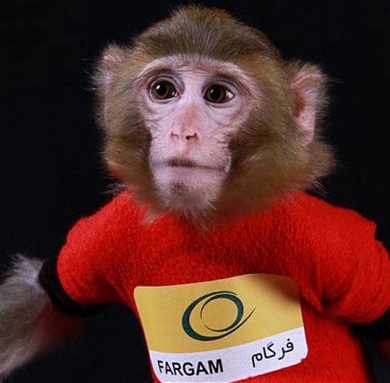December 20-2013

The Islamic Republic Saturday successfully recovered its second monkey lofted into space, an event that got little attention globally as space buffs around the world were focused on China’s successful soft landing of an unmanned mission on the moon.
But Iran largely ignored the Chinese accomplishment to tout its own success sending Fargam, Farsi for Accomplishment, on a 15-minute trip from Iran’s Semnan province rocket launch site to the edge of space and back. Fargam is a three-kilo male rhesus monkey.
This was the second monkey successfully fired into space and recovered. The first was Pishgam (Pioneer), launched last January 28.
Fargam, like Pishgam, was lofted atop a “sounding” rocket, not a ballistic missile. A ballistic missile flies in an arc from one point on earth to another. A sounding rocket is fired straight up until it runs out of fuel and then plummets back to earth. At some point during the fall, the capsule carrying Fargam was detached from the rocket and returned to earth by parachute.
The monkey was never put in to orbit. It just went up 120 kilometers (75 miles) and down. The entire flight took less than 15 minutes. Iran touted the flight as the latest step in Iran’s effort to put a man into space.
So far, only Russia, the United States and China have put men in orbit. Three other countries have manned space flight programs under way with target dates of orbiting humans of 2015 for India, 2021 for Iran and 2025 for Japan.
The Saturday launch was the seventh in the series of sounding rocket shots that Iran calls Kavoshgar or Explorer. But Iran said Saturday’s launch involved a new rocket with a liquid propellant named Pajoohesh or Research. The six previous launches involved solid propellant.
Iran said the use of liquid propellant meant the rocket accelerated less quickly than with solid propellant and was safer for the monkey.
Iran lost at least one monkey in this test series. In August 2011, Iran fired Kavoshgar 5. Weeks beforehand, officials said the test would involve a monkey. But it only announced the flight had been carried out two months afterward, when an official said the flight “had not accomplished all its objectives,” a polite way of saying the monkey had died. Iran has never said what happened, whether the rocket blew up in flight, or the monkey did not survive the launch or whether the capsule parachute failed.
Kavoshgar 6 last January 28 appeared to be a full success with the monkey recovered safely.
The Kavoshgar and monkey program is different from Iran’s satellite program. Satellites are launched on ballistic missiles, not sounding rockets. Iran put its first satellite into orbit February 4, 2009. Two more have been orbited since then. In recent months, Iran has been announcing constantly shifting plans for the launch of its next satellite.
All of Iran’s satellites so far have been what are called micro-satellites—satellites weighing less than 100 kilograms. The weight is limited by the size of Iran’s rockets.
The first living creature launched into space was a group of fruit flies placed atop a US rocket in 1947. The Americans launched a rhesus monkey named Albert in 1948. Altogether five Alberts were launched over the next few years, but none survived.
The most famous space animal was a Russian dog, Laika, who was fired into orbit more than a half-century ago in November 1957 aboard the second Soviet satellite. Information on her heart rate and other reactions to the launch were radioed back to earth. But there was no way to return her to earth and Laika died in orbit. The Soviet dog launch came only weeks after the Soviet Union puts the world’s first satellite into orbit, not four years as was the case for Iran.
The United States used a monkey rather than a dog for its animal flight tests. Iran has not explained why it decided to use the American rather than the Soviet test procedure.






















